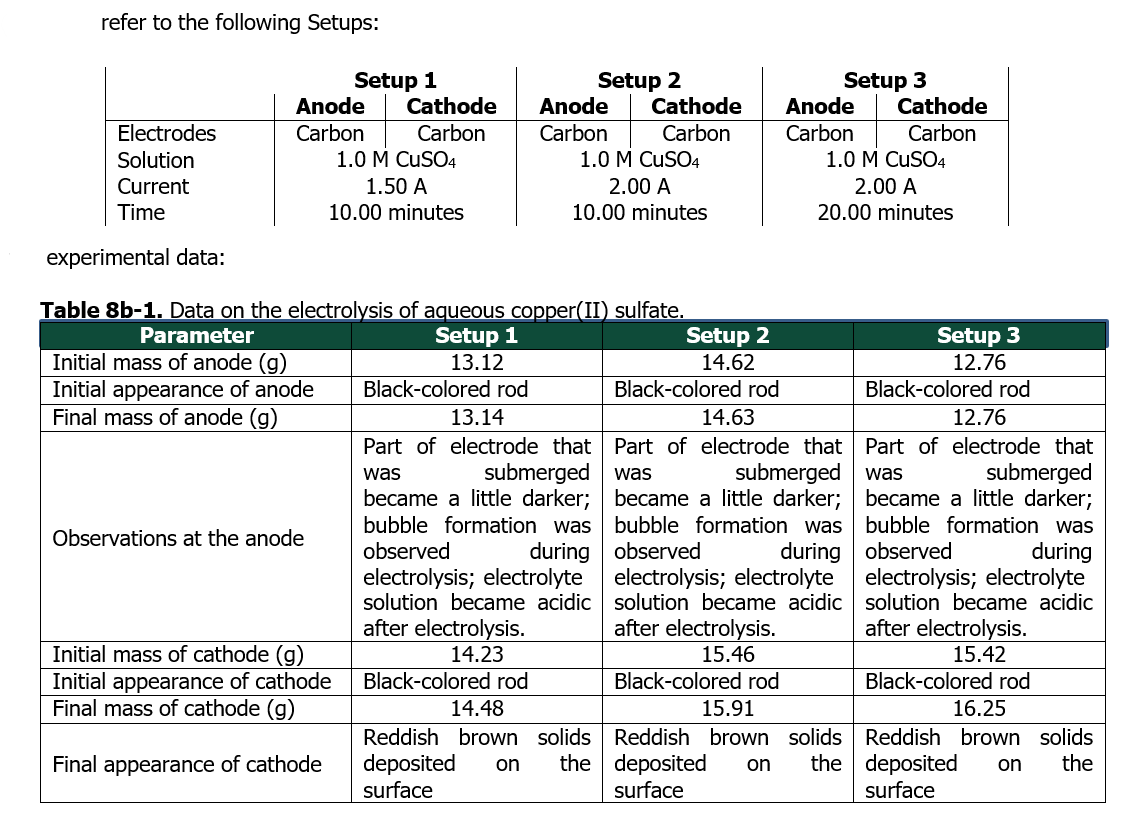In the 1.0 M CuSO4 solution, the following species are present: Cu²+, SO4², H₂O, H³O*, and OH*. Based on the observed changes that occurred in each electrode, write the RHR, OHR, and the balanced overall reaction of the electrolytic cell. The reactions should be consistent with the observations.
In the 1.0 M CuSO4 solution, the following species are present: Cu²+, SO4², H₂O, H³O*, and OH*. Based on the observed changes that occurred in each electrode, write the RHR, OHR, and the balanced overall reaction of the electrolytic cell. The reactions should be consistent with the observations.
Chapter18: Electrochemistry
Section: Chapter Questions
Problem 115AE: The saturated calomel electrode. abbreviated SCE. is often used as a reference electrode in making...
Related questions
Question

Transcribed Image Text:In the 1.0 M CuSO4 solution, the following species are present: Cu²+, SO4², H₂O, H³O+, and OH. Based on the
observed changes that occurred in each electrode, write the RHR, OHR, and the balanced overall reaction of the
electrolytic cell. The reactions should be consistent with the observations.

Transcribed Image Text:refer to the following Setups:
Anode
Electrodes
Carbon
Solution
1.0 M CUSO4
1.0 M CUSO4
Current
1.50 A
2.00 A
Time
10.00 minutes
10.00 minutes
experimental data:
Table 8b-1. Data on the electrolysis of aqueous copper(II) sulfate.
Parameter
Setup 1
Setup 2
14.62
13.12
Initial mass of anode (g)
Initial appearance of anode
Final mass of anode (g)
Black-colored rod
13.14
Black-colored rod
14.63
Part of electrode that
was
submerged was
became a little darker;
bubble formation was
observed
during
electrolysis; electrolyte
solution became acidic
after electrolysis.
Part of electrode that
was
submerged
became a little darker;
bubble formation was
observed
during
electrolysis; electrolyte
solution became acidic
after electrolysis.
14.23
Black-colored rod
Setup 3
12.76
Black-colored rod
12.76
Part of electrode that
submerged
became a little darker;
bubble formation was
observed
during
electrolysis; electrolyte
solution became acidic
after electrolysis.
Observations at the anode
15.46
15.42
Initial mass of cathode (g)
Initial appearance of cathode
Final mass of cathode (g)
Black-colored rod
Black-colored rod
15.91
14.48
16.25
Reddish brown solids
Final appearance of cathode
Reddish brown solids
Reddish brown solids
deposited on the deposited on the deposited on the
surface
surface
surface
Setup 1
Cathode
Carbon
Setup 2
Anode Cathode
Carbon
Carbon
Setup 3
Anode
Carbon
Cathode
Carbon
1.0 M CUSO4
2.00 A
20.00 minutes
Expert Solution
This question has been solved!
Explore an expertly crafted, step-by-step solution for a thorough understanding of key concepts.
Step by step
Solved in 2 steps

Knowledge Booster
Learn more about
Need a deep-dive on the concept behind this application? Look no further. Learn more about this topic, chemistry and related others by exploring similar questions and additional content below.Recommended textbooks for you


Chemistry
Chemistry
ISBN:
9781305957404
Author:
Steven S. Zumdahl, Susan A. Zumdahl, Donald J. DeCoste
Publisher:
Cengage Learning

Chemistry: An Atoms First Approach
Chemistry
ISBN:
9781305079243
Author:
Steven S. Zumdahl, Susan A. Zumdahl
Publisher:
Cengage Learning


Chemistry
Chemistry
ISBN:
9781305957404
Author:
Steven S. Zumdahl, Susan A. Zumdahl, Donald J. DeCoste
Publisher:
Cengage Learning

Chemistry: An Atoms First Approach
Chemistry
ISBN:
9781305079243
Author:
Steven S. Zumdahl, Susan A. Zumdahl
Publisher:
Cengage Learning

Principles of Modern Chemistry
Chemistry
ISBN:
9781305079113
Author:
David W. Oxtoby, H. Pat Gillis, Laurie J. Butler
Publisher:
Cengage Learning


Principles of Instrumental Analysis
Chemistry
ISBN:
9781305577213
Author:
Douglas A. Skoog, F. James Holler, Stanley R. Crouch
Publisher:
Cengage Learning